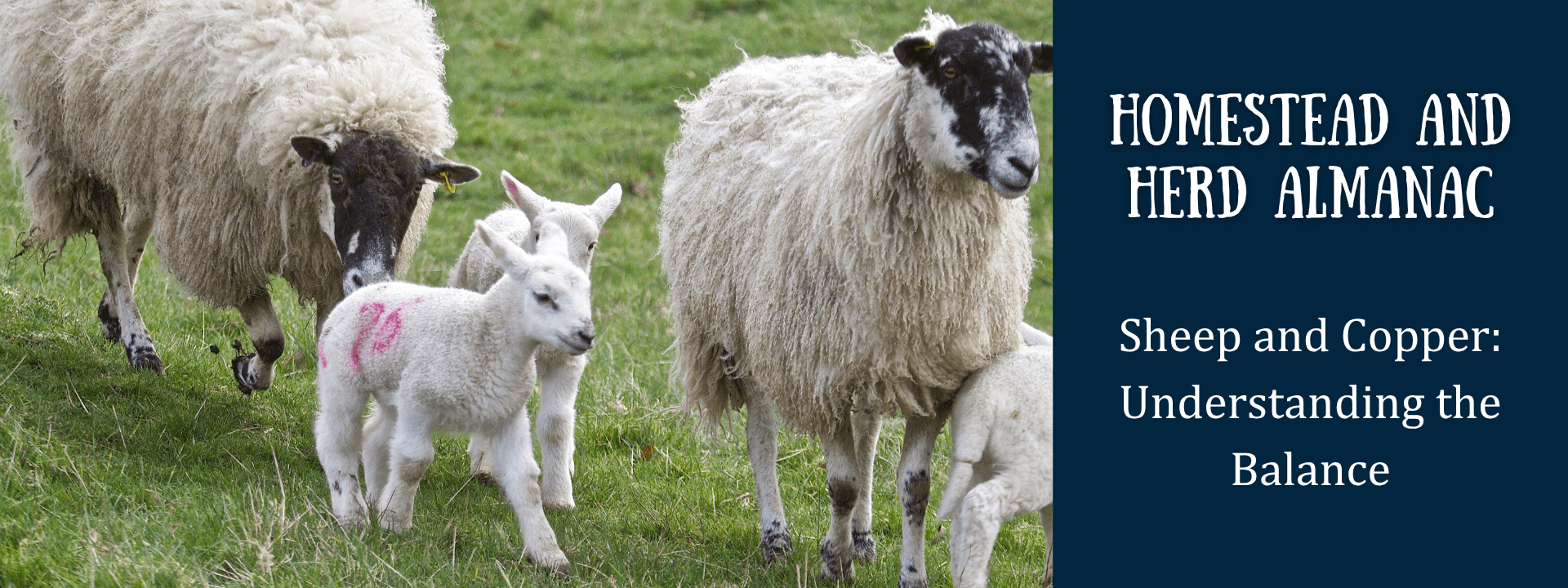
Sheep and Copper - Understanding the Nutritional Balance
When it comes to copper, sheep walk a fine line. This essential trace mineral supports nearly every major system in the body, yet too much can be deadly. While copper toxicity has a well-earned reputation for causing rapid losses, more sheep actually die from copper deficiency than from toxicity. Understanding the balance between the two is key to maintaining flock health and productivity.
The Role of Copper in Sheep Health
Copper (Cu) is an essential micronutrient that supports a wide range of metabolic functions, including:
- Formation of connective tissue, keratin, and wool
- Iron metabolism and red blood cell production
- Immune function and antioxidant defense
- nervous system development and myelin formation
- Pigmentation (melanin) for skin and wool color
When copper levels are too low, sheep may show poor growth, anemia, loss of wool crimp, faded coat color, infertility, and a weakened immune system. Severe deficiencies can lead to swayback in lambs – a neurological disorder caused by inadequate copper in the ewe’s diet during pregnancy.
In fact, many more sheep die or suffer from the effects of copper deficiency than from copper toxicity, largely because producers are understandably cautious about providing too much. The challenge is to meet – but not exceed- the narrow requirement range sheep need to thrive.
Why Sheep Are Sensitive to Copper
Sheep are unique in that their bodies are poor at excreting excess copper. Instead, copper accumulates in the liver over time. Once the liver’s storage capacity is exceeded, the mineral is suddenly released into the bloodstream, leading to destruction of red blood cells (hemolysis) and often death.
This delicate balance means both underfeeding and overfeeding copper can have serious consequences. Feeds formulated for cattle, goats, or horses often contain higher copper levels and should never be fed to sheep.
Copper Toxicity in Sheep
Copper toxicity comes in two main forms:
1. Chronic Copper Toxicity
This is the most common type, developing slowly over weeks or months as small amounts of excess copper accumulate in the liver. Once liver storage is exceeded, a stress event (such as transport, disease, or poor nutrition) can trigger a sudden release of copper into the bloodstream, destroying red blood cells.
Risk Factors and Thresholds:
- Toxicity can develop when sheep consume around 3.5 mg of copper per kg of body weight daily over time.
- The maximum safe concentration in feed is approximately 25ppm.
Signs and Outcomes:
- Depression, weakness, loss of appetite
- Reddish-brown or dark brown urine
- Teethe grinding, excessive thirst
- Death within 24-48 hours once symptoms appear
2. Acute Copper Toxicity
Acute poisoning is far less common and typically results from a large single exposure – through contaminated feed, supplements, or copper-containing products. A dose of 20-200 mg/kg body weight can be fatal.
Symptoms appear quickly and include severe gastroenteritis, shock, and death within hours to days. If the animal survives longer than 48 hours, liver and kidney failure often follow.
Copper Deficiency in Sheep
Just as dangerous – if not more so – is a lack of copper in the diet. Copper deficiency impairs nearly every major body system and can be subtle at first.
Common signs include:
- Faded or “steely” wool lacking crimp
- Poor growth or weight loss
- Anemia
- Infertility and weak lambs
- Swayback on newborn lambs
- Increased susceptibility to disease
Deficiency is more likely in regions with high soil molybdenum, sulfur or iron, which can tie up copper and make it unavailable to the animal – even when total dietary copper appears adequate.
Breed Difference and Copper Tolerance
Sheep breeds vary widely in their tolerance to copper:
- Highly susceptible: North Ronaldsay, Suffolk, Texel, Bluefaced Leicester, Charollais
- More tolerant: Merino, Cambridge
These genetic differences mean that even withing one flock, management practices and mineral choices should be breed-aware.
Finding the Right Balance
Preventing both deficiency and toxicity depends on precision and consistency:
- Feed only sheep-specific minerals and rations. Avoid using goat, cattle, or horse feeds.
- Monitor local forage and water for copper, molybdenum, and sulfur levels.
- Work with a nutritionist or veterinarian to evaluate liver copper concentrations if problems arise.
- Avoid overcorrection. If deficiency is suspected, make gradual adjustments – abruptly adding high-copper feeds can create new risks.
Copper is one of the most important – and most misunderstood – minerals in sheep nutrition. While toxicity is a real and serious threat, deficiency remains the more common killer. Healthy flocks depend on getting copper levels just right.
